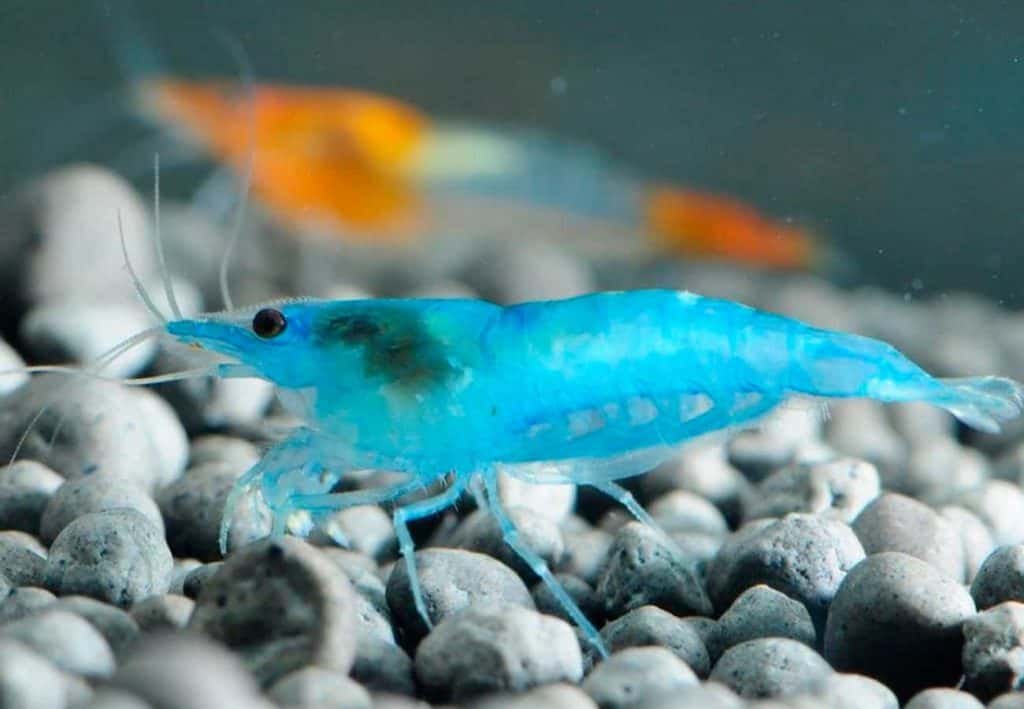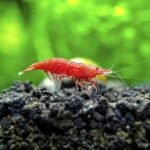The blue velvet shrimp is a variation of the blue color of the cherry shrimp. They are small members of the cleaning team, designed to clean biofilm and algae that form on the surfaces of your vegetation. Follow all the facts and secrets about these beautiful blue creatures. The Blue Velvet shrimp is a species of crustacean popular with aquarium enthusiasts.
Blue Velvet Shrimp Care: The Complete Guide
Blue velvet shrimp is a freshwater shrimp species that look stunning. Its vibrant blue hue is almost fake when you see it. There are some excellent numbers of aquarists who want one or two on their aquarium. These shrimp are easy to care for and beneficial for your entire tank. Though this animal is low on maintenance, there will be something you will need to provide to them. This article will give you the basics regarding this shrimp care.
Summary of species
The Blue Velvet Shrimp (Neocaridina davidi) is a unique freshwater species prevalent in the aquarium trade. This species is just a different color variation from the red cherry shrimp, which is pretty popular. There are no clear explanations for how color changes occur. In your tank, it spends most of its time scavenging for organic matter, including algae and biofilm.
What is a blue velvet shrimp?
The blue Velvet Shrimp is the color morph of the Cherry Shrimp (Neocaridina davidi). It comes from the Atyidae family of freshwater shrimp. This color doesn’t occur in the wild. When fully grown, they usually reach around 1 inch but only live for 1 to 2 years. They can also be placed within tanks of five gallons. The color is determined based on the proportion of blue relative to black on the shrimp body. Usually, shrimp is used to clean algae.
Species Overview, Appearance & Origin
The species are freshwater dwarf shrimps and can grow for as little as 1.5-2 inches. They have a cerulean color body which can variably range from light to intense colors. Their origin is still debated – and not a clear answer is yet expected. Many varieties currently sold from hobbyists and tank owners are farmed and reared, but some are wild and originate in Southeast Asia, such as Taiwan. Their natural habitat lives in freshwater surroundings like streams and ponds with rocky floors amidst numerous plants and wood for concealing and feeding requirements.
Appearance
They have the typical shrimp body with three pairs of walking feet and two maxillipeds. Their abdomen is relatively thick and begins to taper off just before the thorax. They may have relatively soft antennae which move at regular intervals. Their head, tail, feet, and abdomen are roughly the same color. There may also be light dots; These are more condensed in the rear of the body. These shrimp’s eyes often have as much darker color as those from other types in nature.

Cute but just tiny meals 🙁
They are amazing. But you know, they are small enough that little fish can devour them in a day! So be careful with your choice of tank mates.
Life span
Blue-velvet shrimps survive for roughly one to two years. Lifespan will ultimately depend on the quality of the breeding and on the care the tank provides during its lifecycle.
Shrimp overview
Blue Velvet Shrimp are selectively raised from chocolate shrimp born in Taiwan. Blue Velvet Shrimp are straightforward to care for because they can adapt to an extensive range of water conditions. It’s relatively easy for them to breed within an aquarium. Female shrimp carry the eggs for about 30 days until they hatch. We recommend you keep only one variety of Neocaridina shrimps within the tank because of crossbreeding. Crossbreeding also reverts the offspring to wild color. You can keep blue velvet shrimp in soft or hard water. Freshwater shrimp is excellent in fighting algae and eat food leftovers. It is best when kept in mature tanks. These shrimp have to be held in a tank with small fish which will not eat them.
The origin of Blue Velvet Shrimp and Blue Dream Shrimp
Some shrimp breeders believe Blue Dream, Neocaridina originated from Carbon Riili shrimp. Other shrimp lovers believe the blue Velvet shrimp are the result of Crossbreeding. We should never cross breed Blue Dream shrimp with Blue Velvet shrimp. The Blue Jelly shrimp with the Red color is known as the Blue Jelly or the Blue Velvet. Blue Velvet is the result of different genetic types. As a result, it will cause offspring with varying coloration.
Difference between Blue Velvet Shrimp and Blue Dream Shrimp
There is lots of confusing information about the blue color and different names in the shrimp hobby. There can be hardly any uniform assessment system for different colored variations. Because of this growing popularity, shrimp are creating their pattern or color variations. For example, now in the market, you can find Blue velvet shrimp, Blue topaz shrimp, Blue Diamond Shrimp, Blue Fairy Shrimp, and other varieties.
Detailed Guide to Blue Velvet Shrimp: Care, Diet
Neocaridina davidi var. ‘Blue Velvet’ requires little care, rapidly reproduces, and is fun to watch. It could easily live in any tropical freshwater aquarium. They can be highly active, productive, and quite hardy shrimps. All these characteristics make it perfect for beginners shrimp keepers as well as more experienced keepers. This shrimp is a great example of Red Cherry shrimp who are very hardy and adjust quickly to their new environment.
Size
Blue Velvets Shrimp is typically 1.5 inches when fully grown, but some females can reach up to 2 “. Their size is dictated by genetic components and the quality of their care in their developing stages.

Blue Velvet Shrimp Care Guide
Blue Velvet Shrimp are sensitive to water quality and can be difficult to acclimate to a new tank. One major issue is copper and zinc poisoning. These metals are present in fertilizers and some fish medicines. Everything that you put in your water shouldn’t contain chemicals. If you must treat one of your fish and there is no safe option, you should remove all shrimp from the tank while the medicine is taken. A helpful rule of precaution is that shrimp’s blue vivid color will fade if the water quality in your tank is in poor condition. The most effective way to acclimatize them is using the dripping method.
Keeping Blue Velvet Shrimp
Dwarf shrimps don’t tolerate ammonia or nitrites in the water. They don’t need a large aquarium; they can flourish in a 5-gallon tank. It’s also competent to adapt to almost any kind of water. Don’t forget to acclimate carefully. Use proper filtration in the shrimp tank. Plants will provide hiding places, extra space for food and can play an essential role in the nitrogen cycle. It’s a great idea to add live plants to the shrimp tanks.
Blue Velvet Shrimp Care
The Blue Velvet Shrimp require little to no maintenance, and they need no specific care of their owner. But there are some particular water parameters and conditions must be satisfied for shrimp to live long and well.
Blue Velvet Shrimp Care Guide & Tank Set Up For Beginners
Blue Velvet shrimp adds a special touch to any hobbyist’s tank. They became popular with people because of their colors and ease of maintenance. Plus, they will rid your tank of the undesirable algae. This guide will show you how to care for blue velvet shrimp and offer the proper tank conditions for the long term most possible. The guide also provides a guide for handling and maintain shrimps in your tank.
Blue velvet shrimp tank requirements
Cherry Shrimps inhabit densely cultivated areas in freshwater rivers in Taiwan. They have a home within groupings of moss usually shaded by long leafy plants. They live near the substrate where the light is small and where they have enough room to hide. In these freshwater waters, the flow remains low, and decaying plant material allows the pH to fluctuate between primary and mild acid conditions.
Blue shrimps requirements
The best start should be a 5-gallon aquarium. Use plenty of live plants to provide safety for your shrimp. Shrimp are highly sensitive to ammonia and nitrite, so this need always is clear from your tank water. Tubes, caves, and driftwood can be used as hide-outs for shrimp when they are ready to molt. If you want to breed blue velvet, be sure to use a sponge filter or at least one prefilter sponge as the fry is tiny, the filtration system can quickly suck them in the filter.
Blue velvet shrimp water quality
Blue velvet shrimp is an underdeveloped and less sensitive dwarf shrimp variety. Keep water parameters stable and use a test kit to ensure it. Even living in places with fluctuating temperatures, a heater to keep the temperature stable is welcome. These shrimp are hardy yet need stable conditions.
Water parameters
Blue velvet shrimp can be easily adapted to their surroundings. It can tolerate temperatures from around 64°F to as high as 82°F. The higher your temperature, the faster it will grow, breed, and die. It’s preferably recommended to store it around 72 F, where the shrimps can breed adequately and live longer. When it comes to pH, it typically prefers a neutral environment, ideally between 6.5 to 8.
Aquarium setup
It would be best if you kept this shrimp in at least five-gallon tanks. The water temperature can range from 57° to 84°F; however, between 72 and 80°F is best. Your filter mustn’t be strong enough to injure or suck the shrimp – a sponge filter is your safest option. You can also use any light intensity, as long that there is some shade in some part of the tank. Plants are the most necessary part of this tank installation. Large leafed plants have vast biofilm deposits as well as attract large algae.
The Nitrogen Cycle
Ammonia nitrite or nitrate is the only weakness of Blue Velvet shrimp. They won’t tolerate and may die if exposed to nitrogenate pollutants. Before adding shrimp to your tank, ensure appropriate bacterial colonies have been established in the filters of your system and that the filtering system is cycled. Nitrate can be taken away by plants or removed from water changes. If you want to know more about the nitrogen cycle and how to cycle your tank, look at our article about it.
What to put in their tank
The ideal Blue Velvet Shrimp tank will be well planted. Plants also serve to provide food to these critters. Java Moss is a popular choice that works well. Rocks and driftwood are fantastic surfaces for algae and biofilm to accumulate. These shrimp species prefer rocky sides but will sift and soak into the soil with a good environment.
Plants & Decor
Live plant activities play a vital role in the nitrogen cycle by eliminating nitrates. Besides, these shrimps have their hiding places where they can be located that make sure they are completely protected. Rocks, caves, and bogwood add crucial layers to your shrimp stock. Ornaments increase the surface area on which algae and bacteria grow, shrimp’s leading diet and nutrition.
Blue Velvet Shrimp Tankmates
In the wild, shrimps are one of fish’s favorite dishes. Almost all fish eat shrimp. The best tankmates for blue velvet shrimp are all types of snails. Check my guides for Malay Trumpet snails, Mystery snails, Ramshorn Snails, Rabbit Snails, White Wizard Snails, and Nerite snails. It would be best if you didn’t have blue shrimp with other Neocaridina species.
Tank Mates
Blue Velvet Shrimp may be combined with Amano Shrimp and Bamboo Shrimp. When it comes to fish, you need to be pickier. Peacefully-oriented species that aren’t too big and aren’t aggressive are an excellent choice. The safest approach is to leave out all types of fish, but for now, we recognize it is not the most attractive option. Many aquarists wonder whether or not it can be successful to pair Blue Velvet shrimp with Betta fish. We do not recommend this because its effectiveness seems to be inconsistent.
The tank mate for blue velvet shrimps
In the wild, these shrimp live in large groups. They live alongside native fish, including smaller cyprinids, catfish, and loaches. Your fish tank mate shouldn’t be big enough to put this cute shrimp in your mouth. Nano fish like Oto catfish, corys, Chili Rasboras, Lampeyes, and Endlers will make your best combination. Smaller fish that generally only eat micro prey are safe to keep with blue velvet shrimp. A good tankmate is a peaceful creature that doesn’t think of shrimp or her babies as food sources. Some fish species in aquariums are friendly enough to coexist with shrimp during the time in the tank. Some methods can help improve fish companionability and compatibility with shrimps. Ensure that the shrimp are given plenty of hiding places from the fish and that the tank is long enough to hold both without constant clash.
Blue velvet shrimp diet
Dwarf shrimp-like blue velvets are omnivores that thrive on diversified diets. You’ll frequently see the animal foraging for biofilm, algae, and debris. There is much excellent shrimp food which works well as a staple diet. You can also offer frozen foods, algae tabs, tropical fish foods, and vegetables.
Diet and feeding
They consume microbiome, biofilm, and algae that accumulate onto the plant leaves and tank parts. If you saw them grazing on your plant’s leaves, don’t be worried. They do not eat live plants; like many shrimp, they will eat everything they can locate at the bottom. They prefer green vegetables like lettuce, spinach, cucumber, and broccoli.
Food & Diet
Blue velvet shrimps are scavenger predators who spend their time searching for all food sources, like algae and biofilm. Standard flakes or fish food pellets are a perfect choice for this species and provide a smooth base diet. Ensure not to overfeed. Overfeeding will cause harmful effects on the shrimp and an increase of ammonia in your tank.
The diet of blue velvet shrimp
As long as an alga or microbe in the water is present, Blue Veal shrimps will generally require minimal food. If you have plants, you can find them constantly looking at them and grazing on them. They will eat dead, rotting, or decomposing plants. The more diverse their diet, the more essential nutrients they’ll have for good growth and molting.
Breeding blue velvet shrimp
The shrimp is a good breeder and a good breeding project to create your own. During pregnancy, the female will carry small eggs, which hatch into mini shrimp. The fry can be kept in the same tank as the parents and immediately start forage and eat. Keep your water quality high and provide a diversified diet to keep the shrimp healthy.
Breeding
Put the pair in a breeding tank without fish and keep suitable water parameters. Once the shrimps mate, the female will carry around the eggs under her tail. Your only role in this instance will be to ensure that enough algae and biofilm are left in the tanks for feeding the young ones. It will be their crucial nutrition source, although you may supplement some algae tablets if needed. In roughly 90 days, Blue Velvet Shrimp will be ready for reproduction.
In-Tank Behavior & Temperament
Blue Velvet shrimps can be very social and curious animals. They tend to shy away from their fish companions but do not become violent when near others. They’re very active; you’ll probably find them all over the tank searching for food, which can be funny.
Behavior & Temperament
Blue Shrimp are very straightforward and can easily be kept or bred. Their temperament seems peaceful, so finding friends is easy. Like most shrimp, they prefer being focused on their business, leaving their tank mates alone. You could see them under a rock, on the bare ground near the surface, or practically anywhere. The babies are amazing to watch, thanks to their bright colors.
Common possible diseases
Even most minor copper deposits in your tap water can be deadly. Intoxication is probably the most common mistake a homeowner makes. If you start adding medications to your aquarium, you will likely have to move the shrimp to another tank. Blue Shrimp is often brought in established tanks that have been tested. Put them in mature, well-established tested tanks is usually the best approach! Blue velvet and copper can’t mix. Some fish medication contains significant levels of copper means that you will kill your shrimp while treating your fish.
Final thoughts on blue velvet shrimp
Blue velvet shrimp are a good choice for your freshwater aquarium. They have a beautiful blue color, are fun to watch, easy to breed, and need minimal care. They will continue growing and prospering once you provide them with an appropriate water parameter and another tank setup. We hope this guide will help you decide on becoming a valid Blue Velvet shrimp owner.







![[Updated] Top 10 Best Turtle Food (Review) in 2023 [Updated] Top 10 Best Turtle Food (Review) in 2023](https://aquariumhunter.com/wp-content/uploads/2021/08/Best-Turtle-Food.jpg)